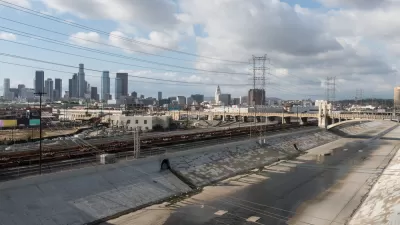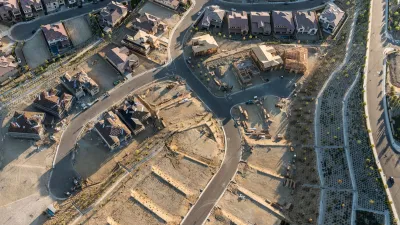Los Angeles has a heat problem, and it's getting worse. But the Mayor's Office is taking on the challenge.

The Los Angeles Office of Sustainability is partnering with local universities on a plan to lower the average regional temperature by three degrees over the next 20 years.
Achieving that goal could reduce energy consumption, improve air quality, and prevent deaths caused annually by extreme heat. The Los Angeles Times looks into how much progress the city needs to make on science and policy to get there.
A variety of factors go into L.A.'s temperatures, but one well-known problem scientists are focusing on is the urban heat island effect: the phenomenon by which cities tend to be warmer than their surrounding areas because of heat absorbed by the built environment.
Over the years Los Angeles has tried, at different scales, a number of common approaches to this problem, including cool pavements and cool roofs, sustainably designed parks, and thoughtful urban forestry.
But because the effects of a heat island can be "hyper-local," its solutions have to be, too—sometimes varying "block to block." In one neighborhood, scientists tested different heat mitigation techniques in a computer model that accounted for every single tree and building.
FULL STORY: L.A.’s mayor wants to lower the city’s temperature. These scientists are figuring out how to do it

Study: Maui’s Plan to Convert Vacation Rentals to Long-Term Housing Could Cause Nearly $1 Billion Economic Loss
The plan would reduce visitor accommodation by 25,% resulting in 1,900 jobs lost.

North Texas Transit Leaders Tout Benefits of TOD for Growing Region
At a summit focused on transit-oriented development, policymakers discussed how North Texas’ expanded light rail system can serve as a tool for economic growth.

Why Should We Subsidize Public Transportation?
Many public transit agencies face financial stress due to rising costs, declining fare revenue, and declining subsidies. Transit advocates must provide a strong business case for increasing public transit funding.

How to Make US Trains Faster
Changes to boarding platforms and a switch to electric trains could improve U.S. passenger rail service without the added cost of high-speed rail.

Columbia’s Revitalized ‘Loop’ Is a Hub for Local Entrepreneurs
A focus on small businesses is helping a commercial corridor in Columbia, Missouri thrive.

Invasive Insect Threatens Minnesota’s Ash Forests
The Emerald Ash Borer is a rapidly spreading invasive pest threatening Minnesota’s ash trees, and homeowners are encouraged to plant diverse replacement species, avoid moving ash firewood, and monitor for signs of infestation.
Urban Design for Planners 1: Software Tools
This six-course series explores essential urban design concepts using open source software and equips planners with the tools they need to participate fully in the urban design process.
Planning for Universal Design
Learn the tools for implementing Universal Design in planning regulations.
Ascent Environmental
Borough of Carlisle
Institute for Housing and Urban Development Studies (IHS)
City of Grandview
Harvard GSD Executive Education
Toledo-Lucas County Plan Commissions
Salt Lake City
NYU Wagner Graduate School of Public Service





























